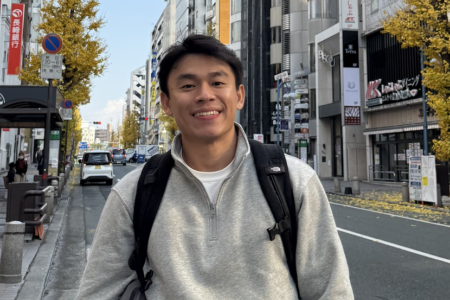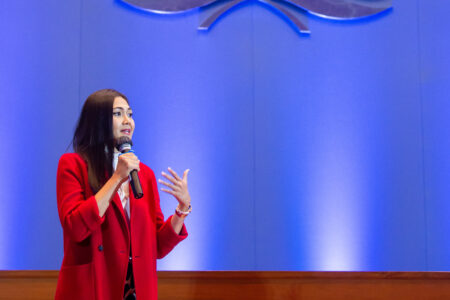
Growing up with parents working in the hospitality industry, I’ve always been naturally drawn to the sector, and even had front-row seats when it came to a crashing halt during the pandemic.
Thankfully, things have changed since then. What was once considered the slowest-recovering industry after the pandemic is now a booming market forecasted to grow around US$5.5 trillion in 2024 and beyond.
But now, it faces different challenges altogether, according to Associate Professor Dr. Joaquim Dias Soeiro. I had the fortunate opportunity to sit down with the extremely decorated Deputy Dean of Internationalisation at the School of Hospitality and Tourism Management, Sunway University in Malaysia, to learn more about his insights on hospitality education and how the industry is evolving as a whole.
View this post on Instagram
Questions, answers, and the best bread pudding I’ve tasted
Soft-spoken. Intelligent. Humble.
These are just but a few words that immediately jumped out at me when I first met Dr Joaquim for lunch.
Wherever we went throughout the university, people smiled and waved at him. When we sat down at Athanor – Sunway University’s restaurant, which served as a real-world training ground for Tourism, Hospitality & Culinary Management students, he was immediately greeted by the chefs, who were lecturers themselves.
As we dined on potato and leek soup and smoked duck pasta, the professor shared a little more about his life. He hails from Cahors, France, and has spent the last 18 years teaching in Malaysia.
“I didn’t plan to stay so long,” Dr Joaquim said, smiling. “I was expecting to stay two or three years to get some international experience, then go back to France to work. But I enjoy Malaysia – the culture, food, people, and overall, the simplicity of everything.”
Dr Joaquim spent many years within Malaysian tertiary education, working with different universities to teach hospitality, develop undergraduate and postgraduate programmes, and even incorporate professional certificates and technologies into teaching.
“There are a few examples, like wine training, specialty coffee, food safety, hotel analytics – these are international certificate programmes we’re working on bringing into the Malaysian curriculum here at Sunway University,” he explained. “The hospitality industry is always changing, and the approach must continue to evolve.”
Over the rest of our lunch meeting, he spoke about how the pandemic brought about major changes in how hotels and tourism were managed, and how technological innovations were now changing how the hospitality industry operated.
By the time we got to the bread pudding, I had even more questions. With the 21st century presenting such rapid technological shifts, how are students and professionals in the hospitality industry handling these changes?
More importantly, how were educators facing this challenge? Hospitality wouldn’t be as simple as teaching students the right ways to serve and talk to customers. For example, we’re often forced to squint at digital menus, scanned through QR codes stuck unceremoniously on restaurant tables – where exactly would the human element of the service industry be in this situation?
But it wasn’t until the week after that we sat down once again for another chat that I had the answers.

A couple of decades ago, perhaps the idea of being served by a robot was merely a fantasy. Source: AFP
How is the hospitality industry changing?
Being familiar with the hospitality industry since a young age, I tend to scrutinise more than most.
Hotels, restaurants, event services – I enjoyed watching how people conducted themselves while carrying out their services, wondering how they could stand the long hours in heels, stuffy suits, or voluminous amounts of hairspray.
My parents were another example. As airline crew, they worked long hours, dealing with cranky, unruly passengers, pushing the heavy meal cart, and lifting cabin baggage for customers, a feat my slender, five-foot-two mother struggled with constantly.
In the not-so-far future, this may change. I sat down once again with the professor, who was eager to share his insight.
“Hospitality is evolving – a slower pace compared to other industries like automotive, but it has its own innovations nonetheless,” Professor Joaquim said firmly. “One of the few good things that came out of the pandemic was that technology evolved, and now we are moving towards more inclusion of artificial intelligence and robotisation.”
I knew what he meant. In Japan, you’ll find hotels run entirely by robots, such as Henn-na Hotel. More and more restaurants were opting out of hiring minimum wage staff in favour of literal robot servers and waiters.
Even on the day of this very interview, I walked by a cleaning robot that was chugging along the sides of the university, gathering trash and sucking up dust. Admittedly, this was my first time seeing one, and at a university campus, no less.
“It’s not limited to these either,” Dr Joaquim said, smiling as I recounted my tale. “Robotisation can be in the housekeeping or F&B department – something that’s helping with vacuuming, disinfecting, washing, ironing, and so on.”
But this piqued my interest further. As writers, we’ve heard the concept of robots and artificial intelligence replacing us all too often. After all, AI is slated to replace 300 million jobs, according to Goldman Sachs in a BBC report.
So how would this change fare for the hospitality industry, a customer-focused, people-centric sector?
Would the future really just be scanning QR codes, waiting for robots to deliver our food and toiletries, and walking through cold hotel lobbies devoid of human services? Was this, as Dr Joaquim described, the “dehumanisation of the service industry?”

Would you prefer exiting your room to the sight of a robot or a human? Source: AFP
“We actually raised this question with a colleague from UKM (Malaysia National University) and conducted a study on the importance of human appearances with robots, and how this would impact customers’ willingness to interact,” the professor said. “One interesting aspect is that people feel more comfortable with a robot that looks like a human.”
He was quick to explain that this didn’t mean having robots à la M3GAN style, so to speak. Rather, it was about ensuring that there was still a human touch within the industry, even if robotisation took over things completely.
“It’s a service industry, after all. While robots are there to do the work, humans must still be there to manage them,” he said. “The staff will then have more time to spend with the consumer in terms of their dining experience, cater to their individual needs and desires, and so on. They focus on the emotional perspective, while the robots are there to take orders and deliver the plates.”
He’s right. Nothing can quite replicate the warmth I feel when servers come up to me to ask how my meal was, or when the hotel manager smiles at me as I make my way through the lobby. If they were to be replaced with robots, that would be a different environment altogether – a cold one, in my opinion.

For those who choose to come to Sunway University for a hospitality degree, you’ll find that your classroom spans beyond the campus grounds. Source: Sunway University
How then, is hospitality taught today?
The evolution of tech also comes with the evolution of its education, a concept that Dr Joaquim was happy to explain.
“Everything is evolving very fast thanks to these technologies, and it impacts the industry. Consequently, it also impacts how we educate and the subjects we need to teach,” he shared. “Back then, it was all paper – now, it’s all about using tablets, AI, IT and POS (point of sale) systems.”
However, for the professor, another aspect was important. The location mattered, too, he explained, as he guided me through the university. Seeing was believing, in this case.
“Asia is a growing hub in hospitality, and lots of things are happening here,” he said while weaving his way through the throngs of students heading to their next class. “There are new hotels, new concepts, new theme parks, and more business expansions. It’s a very good future for Asia.”
We ended up at an observation deck, tucked away in a corner of the university. I was pleasantly surprised to see the view – right before the university was a resort, complete with a five-star hotel, waterslides, rides, and surfing pools. To the left was a wildlife park, which Dr Joaquim cheerily pointed out, was home to over 150 species of animals.
“You can see the white tigers as you walk over the eco-walk,” he said matter-of-factly, as if every university campus had its own walkway over a safari.
View this post on Instagram
He then pointed out what the bridge connected to, just beyond the resort. It was a massive mall – one that I myself went to sometimes – that held over 900 stores, and had its very own four-star hotel next to it. On the right, the Sunway Medical Centre peeked out, a private hospital with facilities dedicated to medical tourism and an aging population.
The locals call it Sunway City, founded by Tan Sri Sir Dr. Jeffrey Cheah, Founder and Chairman of the Sunway Group, a leading conglomerate in Southeast Asia. But for Dr Joaquim, it is a classroom, and he meant it in a literal sense – classes would be conducted across the entire Sunway City.
“It’s an entire lab and a very unique concept” he said, gesturing to the sparkling blue water of the Sunway theme park. “For hospitality students, this is a classroom – a sanctuary. A shopping mall, a resort, multiple concepts of hotels; you can find anything and everything you need to study about the hospitality and tourism industry. From a learning perspective, this is something that international students come here to experience for themselves.”
I was impressed. The vast expense provided numerous opportunities for students – not just hospitality ones, either – to experience, learn from, and even work in, something that Dr Joaquim confirmed.
Of course, I couldn’t leave without requesting for some extra wisdom, and the professor was more than happy to oblige.
“The industry is always changing, and it will continue to do so,” he said. “Always be prepared to learn and manage emerging technologies, and work on developing real-world capabilities. Never be afraid to challenge existing methods or traditional ideas.”










